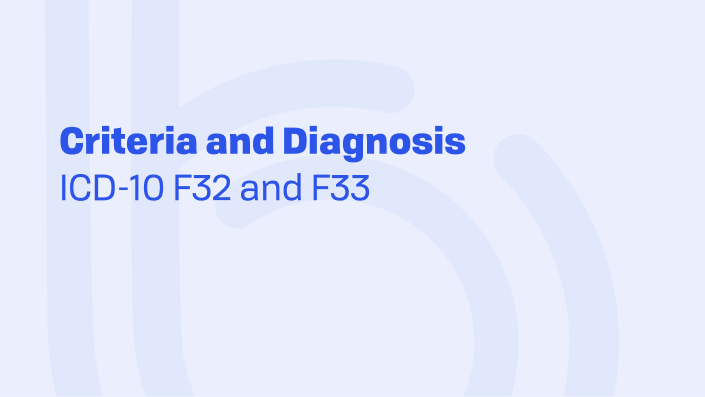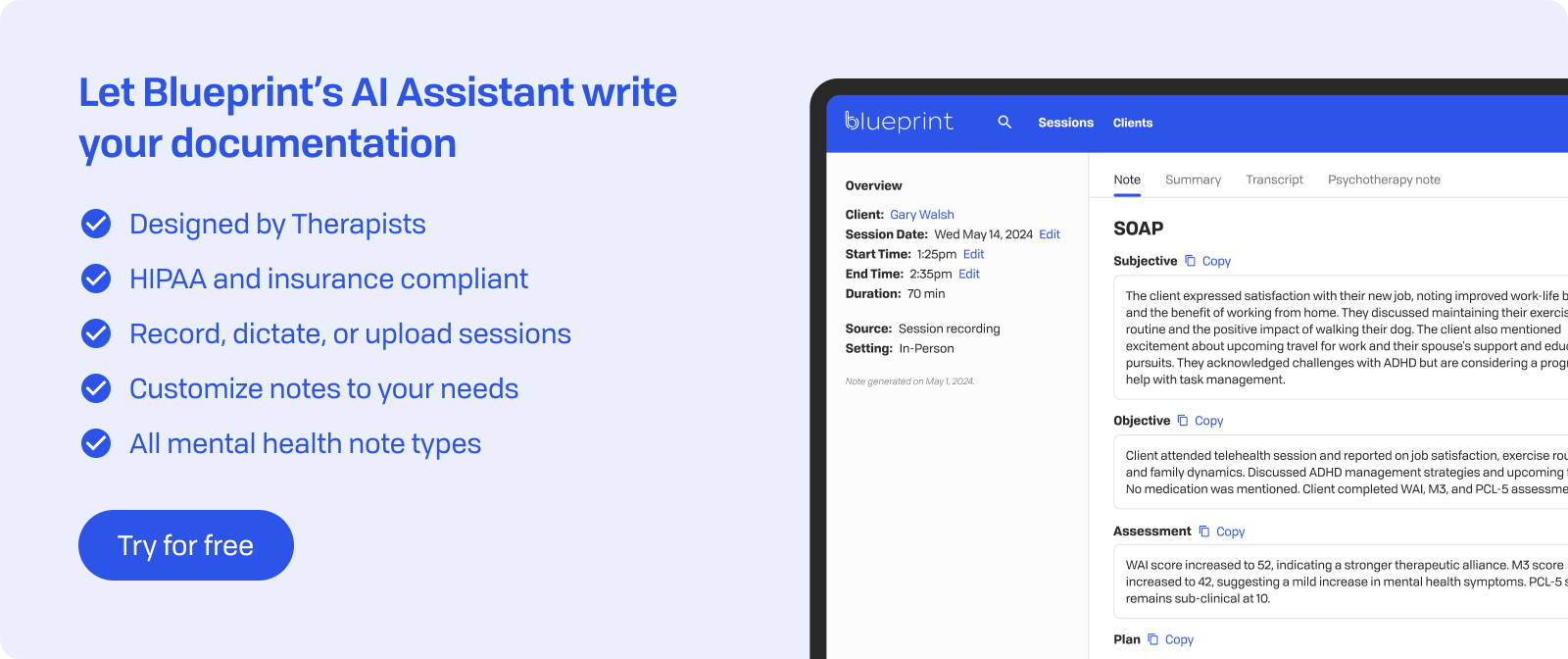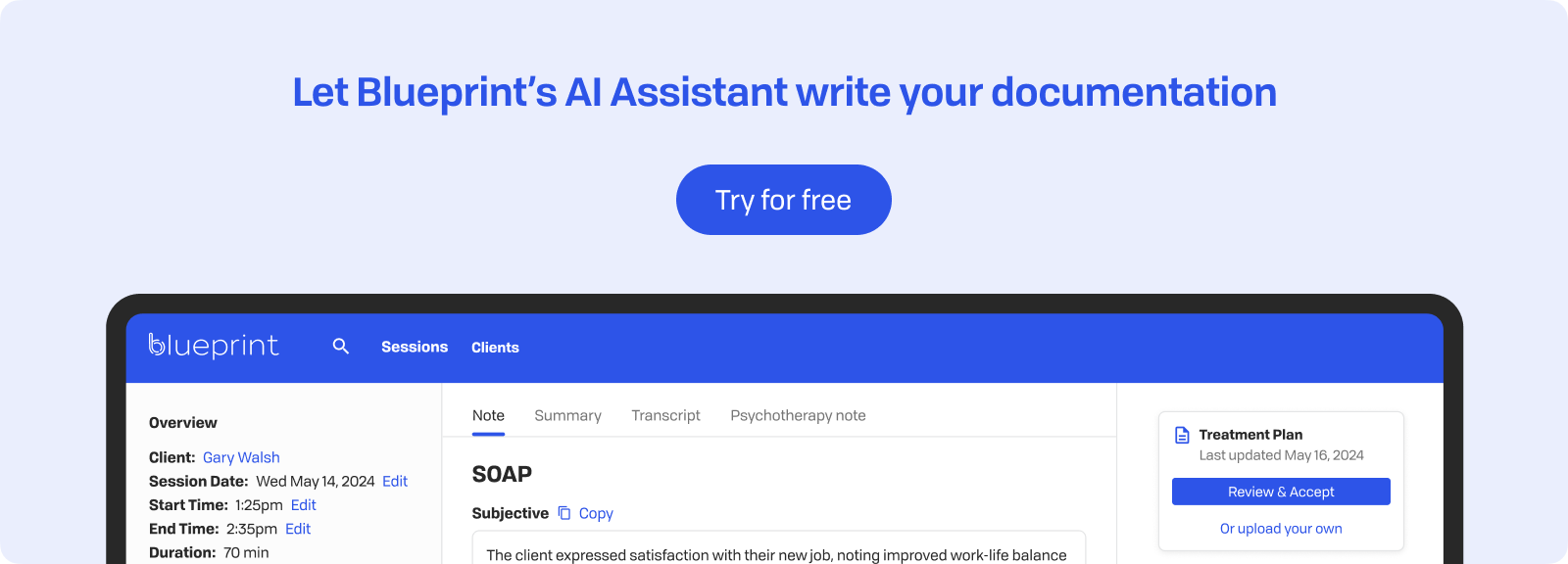
In Brief
Getting the coding right for depression diagnoses can feel like navigating a maze of numbers, intensities, and letters. Yet accurate ICD-10 coding plays a key role in proper documentation, treatment planning, and ensuring your clients receive appropriate care coverage.
The ICD-10 classification system assigns specific codes that describe the nuances of depressive disorders. Knowing these codes helps you pinpoint the specific type and intensity of condition your client is experiencing and communicate more effectively with other healthcare providers and insurance companies, all while maintaining precise clinical records.
Let's look at how the ICD-10 system categorizes depressive disorders and what these codes mean for your practice. With a solid grasp of these classifications, you can streamline your documentation process and support better clinical outcomes.
Overview of Depression ICD‑10 Classification
Depressive disorders are among the most frequently encountered mental health conditions in clinical practice and are coded within the ICD‑10 F32–F33 range. For U.S.-based clinicians, accurate diagnosis relies on applying DSM‑5‑TR criteria to determine whether a client meets the threshold for a depressive disorder, while the corresponding ICD‑10 code is used for documentation and reimbursement purposes.
The ICD‑10 organizes depressive disorders primarily into two major categories:
- F32 — Major Depressive Episode
- Used when a client is experiencing a current episode of major depression.
- Subtypes include mild, moderate, severe (with or without psychotic features), and unspecified.
- F33 — Recurrent Depressive Disorder
- Assigned when a client has had two or more major depressive episodes, with or without full recovery between episodes.
- Severity specifiers (mild, moderate, severe) and psychotic features can also be indicated.
Other related codes include:
- F34.1 — Dysthymia (Persistent Depressive Disorder): Chronic, low-grade depressive symptoms lasting at least two years (one year for children and adolescents).
- F32.8 — Other Depressive Episodes: Used when depressive symptoms cause significant distress or impairment but do not meet the full criteria for a specified subtype (e.g., atypical presentations).
- F32.A — Depressive Disorder, Unspecified: Applied when documentation is insufficient for a more specific code or when the clinician determines the presentation is depressive but lacks enough detail to specify severity or recurrence.
Seasonal Affective Disorder is not a separate ICD‑10 diagnosis. Instead, it is coded as Major Depressive Disorder (F32 or F33) with a “seasonal pattern” specifier in the DSM‑5‑TR. Document the specifier in your notes to support diagnostic accuracy and treatment planning.
These ICD‑10 codes provide a standardized framework for documenting depression, but they must be grounded in the DSM‑5‑TR’s diagnostic criteria, which include core features such as persistent low mood, loss of interest or pleasure, sleep and appetite disturbance, fatigue, impaired concentration, and thoughts of worthlessness or suicide.
Accurate use of the ICD‑10 classification not only ensures reimbursement compliance but also supports effective treatment planning, continuity of care, and clear communication across providers.

Diagnostic Criteria and Symptom Thresholds
For U.S. clinicians, diagnosing depressive disorders involves applying the DSM‑5‑TR criteria to determine whether a client meets the threshold for a depressive episode, while assigning the corresponding ICD‑10 code (F32–F33, F34.1, or F32.A) for documentation and reimbursement.
According to the DSM‑5‑TR, Major Depressive Disorder is diagnosed when at least five of the following nine symptoms are present during the same two‑week period, with at least one being either (a) depressed mood or (b) loss of interest or pleasure:
- Depressed mood most of the day, nearly every day
- Markedly diminished interest or pleasure in most activities
- Significant weight loss, weight gain, or changes in appetite
- Sleep disturbance (insomnia or hypersomnia)
- Psychomotor agitation or retardation observable by others
- Fatigue or loss of energy
- Feelings of worthlessness or excessive/inappropriate guilt
- Diminished ability to think, concentrate, or make decisions
- Recurrent thoughts of death, suicidal ideation, or suicide attempt
Symptoms must cause clinically significant distress or impairment in social, occupational, or other areas of functioning and cannot be better explained by another medical condition, substance use, or bereavement alone.
ICD‑10 Symptom Thresholds
- F32 — Major Depressive Episode (Single Episode):
- Mild: Typically 2 core symptoms + 2 additional symptoms
- Moderate: 2 core symptoms + 3–4 additional symptoms
- Severe: 2 core symptoms + ≥5 additional symptoms, often with marked functional impairment or psychotic features
- F33 — Recurrent Depressive Disorder:
- Criteria as above, with a documented history of ≥2 major depressive episodes
- Criteria as above, with a documented history of ≥2 major depressive episodes
- F34.1 — Dysthymia (Persistent Depressive Disorder):
- Depressed mood for most of the day, more days than not, for ≥2 years (≥1 year for youth), with at least 2 additional depressive symptoms
- Depressed mood for most of the day, more days than not, for ≥2 years (≥1 year for youth), with at least 2 additional depressive symptoms
- F32.8 — Other Depressive Episodes:
- Significant depressive symptoms that do not fully meet thresholds for severity classifications but still cause impairment
- Significant depressive symptoms that do not fully meet thresholds for severity classifications but still cause impairment
- F32.A — Depressive Disorder, Unspecified:
- Used when depressive symptoms are present but insufficiently documented or clinically unclear to assign a more specific diagnosis
When determining the appropriate ICD‑10 code, document both the number and severity of symptoms and their impact on functioning. Clear alignment between DSM‑5‑TR criteria and ICD‑10 classification strengthens treatment planning and supports reimbursement compliance.

Differentiating Single vs. Recurrent Episodes
F33 codes come into play when clients have experienced more than one depressive episode. The difference between F32 (single episode) and F33 (recurrent) codes relies on whether the client has had multiple distinct depressive episodes, with periods of remission lasting at least two months in between.
When coding for major depressive disorder (MDD), recurrent the severity needs to be determined in order to provide the most accurate diagnosis., The current episode's severity determines the specific code used, regardless of the severity of previous episodes:
- F33.0: MDD, recurrent, current episode mild
- F33.1: MDD, recurrent, current episode moderate
- F33.2: MDD, recurrent, current episode severe without psychotic features
- F33.3: MDD, recurrent, current episode severe with psychotic symptoms
- F33.4: MDD, recurrent, in remission
For instance, if a client previously experienced a severe depressive episode but their current episode meets criteria for moderate depression, you would code F33.1 (MDD, recurrent, moderate), not F33.2 or F33.3.
Seasonal affective disorder is a specific pattern of recurrent depression and is typically coded under F33 with appropriate specifiers. The seasonal pattern requires at least two consecutive years of depressive episodes occurring at specific times of year (usually fall/winter) with full remission during other seasons.
Key documentation requirements for recurrent episodes include:
- Episode count: Record the total number of previous known episodes
- Remission periods: Note the duration between episodes
- Current severity: Assess intensity and frequency of symptoms in the present episode
- Pattern recognition: Identify any seasonal or other patterns
This detailed differentiation ensures accurate coding that reflects the episodic nature of the client's depression and informs appropriate treatment planning.

Additional Depression-Related ICD‑10 Codes & Considerations
Several depression-related conditions come with specific ICD-10 codes to capture their unique clinical presentations. Familiarizing yourself with these additional codes allows for accurate documentation and effective treatment planning for various depressive presentations.
Persistent depressive disorder (dysthymia) is identified with the code F34.1. This diagnosis involves depressive symptoms lasting at least two years in adults (one year in children and adolescents) with fewer symptoms than major depression. Clients with dysthymia may experience:
- Chronic low mood on most days
- At least two additional symptoms (such as poor appetite, sleep disturbance, low energy, low self-esteem, poor concentration, or hopelessness)
- No symptom-free period lasting more than two months
Postpartum depression is coded differently based on timing and severity:
- F53.0: Refers to clinical postpartum depression occurring within 12 months after childbirth, requiring active treatment
- O90.6: Used for postpartum mood disturbance. This code covers postpartum blues, postpartum dysphoria, and postpartum sadness with temporary mood changes within 3-4 days post-delivery.
The F53.0 code addresses significant depressive episodes following childbirth that may include sleep disturbance, anxiety, intrusive thoughts about the baby, or thoughts of death. This code is separate from standard depression codes to highlight the unique hormonal and psychosocial factors involved.
Mixed anxiety-depressive disorder (F41.2) is used when clients show both anxiety and depressive symptoms without meeting full criteria for either disorder alone. This code applies when:
- Symptoms cause significant distress or functional impairment
- Neither anxiety nor depression clearly dominates
- The presentation doesn't meet threshold criteria for major depression or specific anxiety disorders
These specialized codes reflect the complexity of depressive presentations and ensure thorough clinical documentation.
Clinical Documentation & Coding Best Practices
Your documentation should clearly state diagnostic criteria met, symptom count, duration, severity, and impact on functioning. Precision in your clinical notes plays a key role in accurate ICD-10 coding and ensures proper reimbursement while maintaining compliance with regulatory standards.
Key documentation elements for depression diagnoses include:
- Symptom inventory: List all symptoms present, noting the intensity, onset, and severity of each one.
- Duration tracking: Document the onset date of symptoms and confirm the two-week minimum threshold.
- Functional impairment: Describe how symptoms affect work, relationships, and daily activities.
- Episode history: Note whether this is a first episode (F32) or recurrent (F33), including dates of previous episodes.
Choose accurate codes instead of defaulting to unspecified ones. For example, use F32.1 for a moderate single episode with 5-6 symptoms, not F32.9 (unspecified). The more specific your coding, the clearer the clinical picture becomes for other providers and insurance reviewers.
Ensure that comorbid conditions receive separate documentation and codes when applicable. Common comorbidities requiring distinct codes include:
- Anxiety disorders: F41.0 (panic disorder), F41.1 (generalized anxiety).
- Substance use disorders: F10-F19 series based on substance type.
- PTSD: F43.10.
- ADHD: F90 series.
Complete documentation within 24-48 hours while clinical details remain fresh. Include direct quotes when relevant, particularly for more severe symptoms, such as statements about suicidal thoughts or psychotic features. Regular self-review of your documentation helps maintain consistency and catch any coding errors before claims submission.

Implications for Treatment Planning & Reimbursement
Accurate ICD-10 coding plays a significant role in medical necessity documentation and insurance reimbursement eligibility. The specificity of depression codes guides treatment decisions and determines coverage parameters that affect both clinical care and practice sustainability.
Severity coding influences important treatment decisions:
- F32.0/F33.0 (Mild): Typically supports weekly therapy sessions, with potential for brief treatment models
- F32.1/F33.1 (Moderate): Typically supports weekly therapy sessions and possibly medication management referrals
- F32.2-3/F33.2-3 (Severe): Validates more intensive therapy schedules, such as twice weekly, or higher levels of care, including intensive outpatient programs or partial hospitalization
Insurance companies use these codes to determine medical necessity and appropriate treatment duration. A diagnosis of F32.2 (severe depression without psychotic features) substantiates different treatment frequencies than F32.0 (mild depression). This coding precision helps prevent claim denials and supports appropriate reimbursement rates.
Risk factors included in coding also shape treatment protocols:
- Psychotic features (F32.3/F33.3): Requires immediate psychiatric consultation and enhanced safety planning
- Recurrent episodes (F33 series): Supports longer treatment durations and relapse prevention strategies
- Postpartum onset (F53.0): Triggers specific screening protocols and potential coordination with obstetric providers
Modern EHR platforms simplify this process through integrated billing and documentation features. These systems automatically suggest appropriate codes based on documented symptoms, reducing coding errors and improving claim acceptance rates. The right technology infrastructure ensures that your clinical documentation seamlessly translates into accurate billing codes, minimizing administrative burden while improving reimbursement rates.
Special Clinical Considerations & Differential Diagnosis
Identifying the differences between depressive episodes and other psychiatric conditions involves careful assessment to ensure accurate ICD-10 coding. Several conditions can show depressive symptoms, but need different diagnostic codes and treatment approaches.
Important differential diagnoses to consider:
- Bipolar and other mood disorders (F30-F31): Check for past manic or hypomanic episodes, as bipolar depression requires different coding and treatment than unipolar depression.
- Adjustment disorder with depressed mood (F43.21): Symptoms directly linked to identifiable stressors lasting less than 6 months.
- Substance-induced mood disorder (F10-F19): Depression symptoms caused by intoxication, withdrawal, or medication effects.
- Depressive disorder due to medical condition (F06.31-F06.34): Direct physiological consequence of conditions like hypothyroidism or stroke.
Cultural and developmental factors greatly affect how symptoms present. What seems like withdrawn behavior in one culture might represent respectful deference in another. Adolescents often show depression through irritability rather than sadness, while older adults may focus on physical complaints over mood symptoms.
Medical evaluation is important to rule out conditions mimicking depression:
- Thyroid disorders
- Vitamin deficiencies (B12, D)
- Chronic infections
- Neurological conditions
Keep a close watch on clients for diagnostic changes during treatment. If psychotic features appear in a client initially coded as F32.2 (severe without psychotic symptoms), update to F32.3 (severe with psychotic symptoms). Similarly, if a client develops manic symptoms, reassess for bipolar disorder and adjust coding from F32/F33 to something more fitting in the F31 category.
Regular reassessment ensures coding accuracy reflects the client's current presentation, supporting appropriate treatment planning and reimbursement.
Key Takeaways
ICD-10 codes for depression follow a structured system that captures episode frequency, severity, and specific presentations. The main distinction lies between F32 (single depressive episodes) and F33 (recurrent depressive disorder), with severity modifiers ranging from mild (.0) to severe with psychotic features (.3).
Important coding principles:
- Count of episodes is important: initial MDD episodes use F32, while any subsequent episodes require F33 codes.
- Severity determines specificity: Document symptom count (4 for mild, 5-6 for moderate, 7+ for severe) to select accurate subcodes.
- Unique codes for special populations: Dysthymia (F34.1) and postpartum depression (F53.0) have distinct classifications.
- Quality of documentation affects reimbursement: Specific codes like F32.1 support claims better than unspecified codes like F32.9.
Accurate depression coding requires a thorough clinical assessment that documents core symptoms (mood, anhedonia, fatigue) plus secondary symptoms over a two-week period. Your notes should clearly indicate functional impairment, episode history, and any comorbid conditions.
Incorporating proper ICD-10 coding into routine practice improves treatment planning, ensures appropriate level-of-care decisions, and reduces claim denials. Remember, coding accuracy isn't just administrative—it directly impacts your ability to provide continuous, properly reimbursed care for clients facing depression.
Mental health clinicians who become proficient in these coding fundamentals create clearer clinical records, improve communication with other providers, and maintain sustainable practices while delivering evidence-based depression treatment.

How Blueprint can help streamline your workflow
Blueprint is a HIPAA-compliant AI Assistant built with therapists, for the way therapists work. Trusted by over 50,000 clinicians, Blueprint automates progress notes, drafts smart treatment plans, and surfaces actionable insights before, during, and after every client session. That means saving about 5-10 hours each week — so you have more time to focus on what matters most to you.
Try your first five sessions of Blueprint for free. No credit card required, with a 60-day money-back guarantee.























